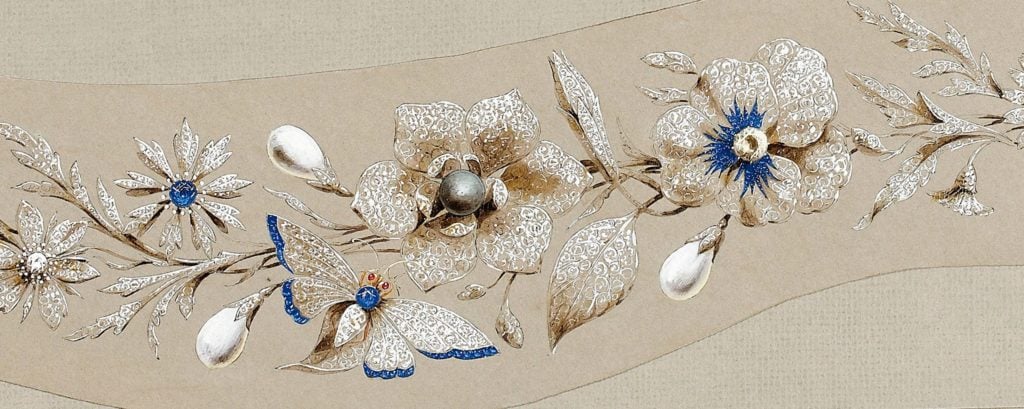In 1991, when the Salon du Dessin—an art fair in Paris dedicated to works on paper—was inaugurated, it was strictly dedicated to “ancient” drawings, pastels, gouaches, and oils on paper, defined as predating the 20th century. This Tuesday, as the 27th edition of the fair opened at the Palais Brongniart (running through March 26), it was clear that it had morphed into what a veteran exhibitor called a different and “eclectic art fair.”
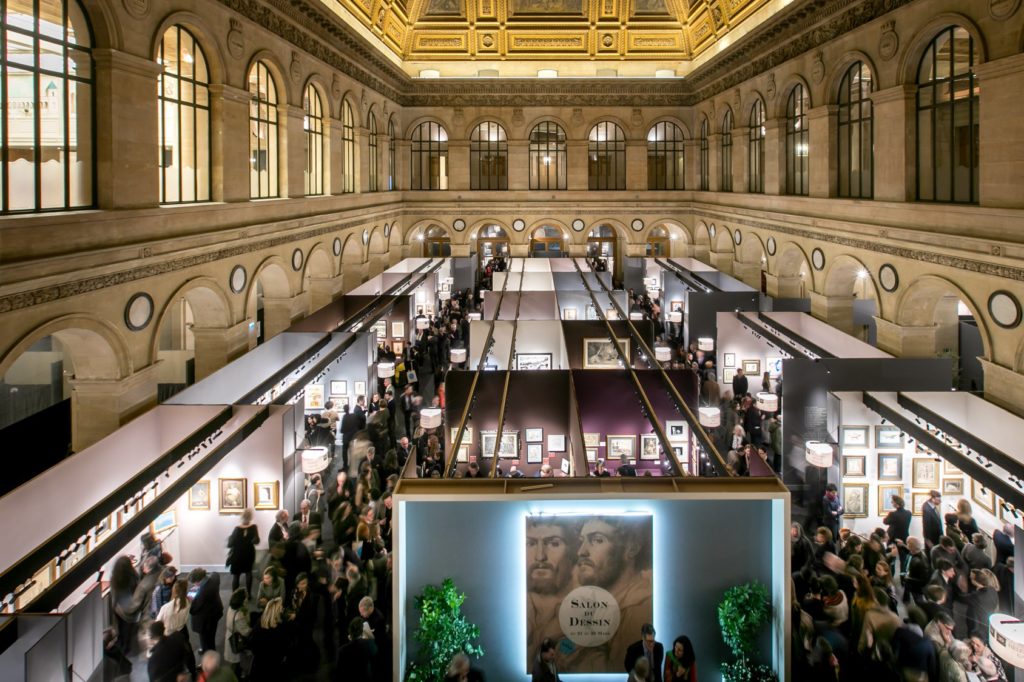
Interior view of the Salon du Dessin, 2018. Photo: Tanguy de Montesson.
“The fair has improved in quality and has become more eclectic,” said Éric Coatalem, an art dealer who has participated in the fair for over a decade. Coatalem’s own stand this year was primarily dedicated to works from the 18th and 19th century, including a rare oil on paper titled Glowing Tiger by the French artist Eugène Delacroix, which hung on a wall otherwise devoted to the 20th-century works. “Opening the fair to larger periods makes it more interesting because it allows a broader vision of artworks on paper,” he said.
By that yardstick, this edition of the fair—held in the 2nd arrondissement in the grand former site of the Paris stock exchange—is even more interesting than before. There are some 40 international galleries whose offerings cover nearly 700 years of art, from the 15th to the 21st century, in a large variety of techniques and formats. And this year there is a new exhibitor of a wholly different genre.
Drawing Inspiration From the Past
For the first time, the French jewelry house Chaumet is participating as an exhibitor, presenting a suite of artworks that persuasively link its history of exquisite design to the artistry seen in the surrounding booths. A series of 38 preparatory sketches selected from among the 80,000 drawings in the house’s archives is collectively presented in a show titled “The Art of Drawing at Chaumet: From Imagination to Creation.”
The drawings—in pencil, ink, watercolor, and acrylic—demonstrate the variety of techniques used by the draughtsmen at Chaumet. Though they are not for sale, they are offered for visitors’ viewing pleasure, and to educate the public about the links between the art of drawing and the craft of making jewelry. Many of the drawings are being shown for the first time.
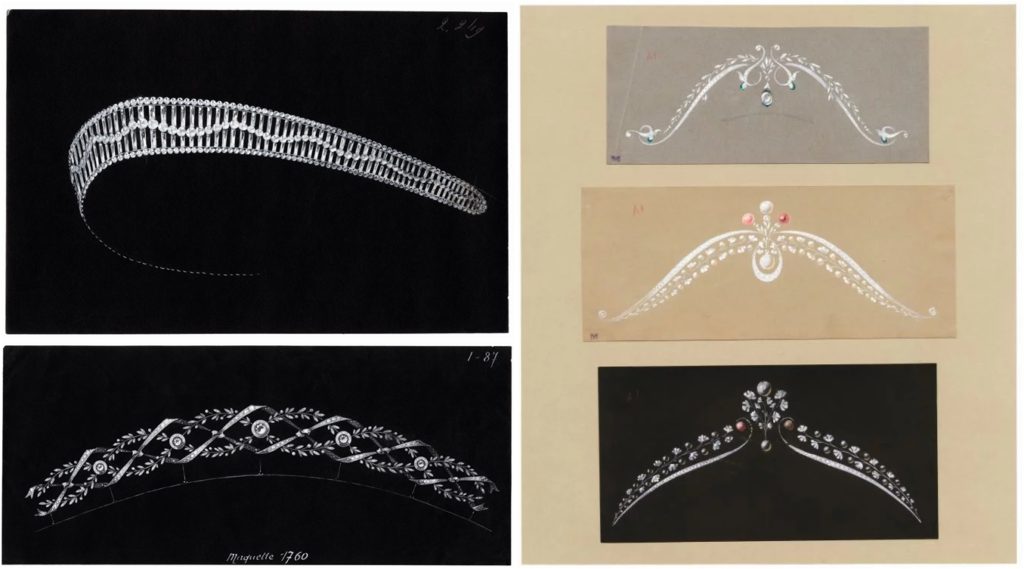
Preparatory sketches from Chaumet. Courtesy of Collection Chaumet, Paris.
The idea to show the drawings at an art fair came from Jean-Marc Mansvelt, the chief executive of Chaumet since 2015, whose strategy has favored a “cultural” repositioning of the maison. “In the past three years we have taken the opportunity to showcase the rich artistic heritage of the maison,” Mansvelt said. “We have done this with the “Imperial Splendors” show at the Forbidden City in Beijing, a museum show that will be traveling next to Tokyo, and with our own in-house pop-up museum. Chaumet’s presence in the Salon du Dessin confirms our close ties to the world of art and culture.”
Covering a date range from 1810 to the mid-1950s, Chaumet’s drawings focus on the theme of the “tiara,” naturally a recurrent subject for a jeweler who has been a purveyor of French kings and emperors for over two centuries. Chaumet created over 3,500 headpieces during that time, many of which were worn to project royal authority.
“Drawing is the first step in the creative process that leads to the conception of a piece of jewelry, be it for a whole collection or a single private order,” said Guillaume Robic, Chaumet’s heritage director. “Our goal with this exhibition is to show the successive stages in the creative process of designing a piece jewelry,” he explained. “It is also to demonstrate the creativity of the maison for 240 years, and to show where we find our inspiration for today’s jewelry collections.”
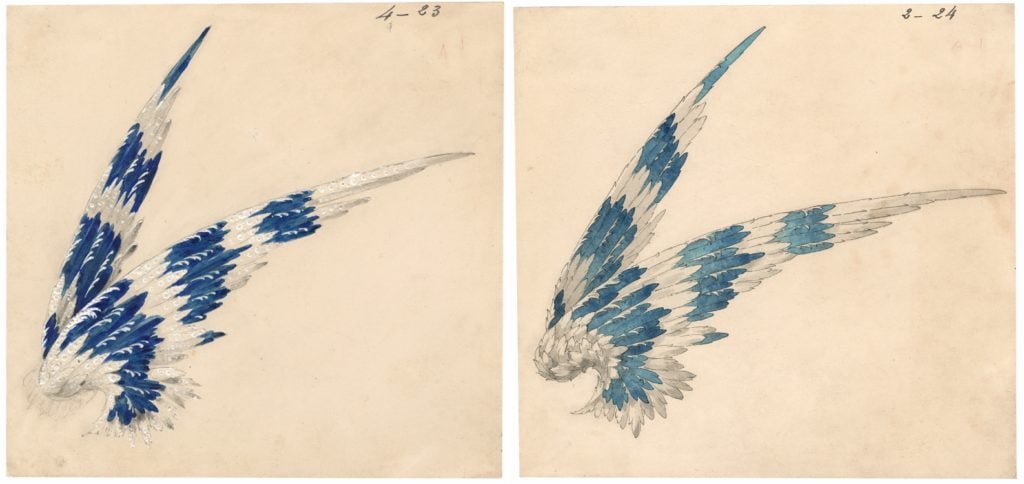
Preparatory drawing for Vanderbilt Tiara (ca. 1908). Courtesy of Collection Chaumet, Paris.
While preparatory drawings are essentially “technical” drawings rarely signed by, or attributed to, a single artist, they are nevertheless both strikingly delicate and highly realistic. The gouachés (or watercolors) that highlight pencil drawings are particularly vibrant, allowing for the sheen of a pearl or the crystal clarity of a diamond to leap off the page. Still, while the jewelry drawings are qualitatively on par with the art shown elsewhere in the fair, they were often treated as a “work-in-progress” in jewelers’ workshops, subject to change if the client opted for a modified design, or for different stones.
“Two drawings from 1810 shown here are among the oldest in our archives, and mark the beginnings of the maison,” said Mikael Lepage, who oversees Chaumet’s archives. “They are drafts of designs for tiaras intended for the Empress Marie Louise, wife of Emperor Napoleon, whose official jeweler was Chaumet.” In 1901, Joseph Chaumet had proposed a tiara to the American artist and heiress Gertrude Vanderbilt Whitney, founder of the Whitney Museum in New York, that was shaped like a pair of diamond wings mounted on an aigrette, a feathered-adornment meant to mimic a bird’s spray of plumage that was particularly en vogue during the Belle Époque. Various stages of the drawings for the Vanderbilt tiara along with a three-dimensional prototype wrought in nickel-silver are on display in the booth.
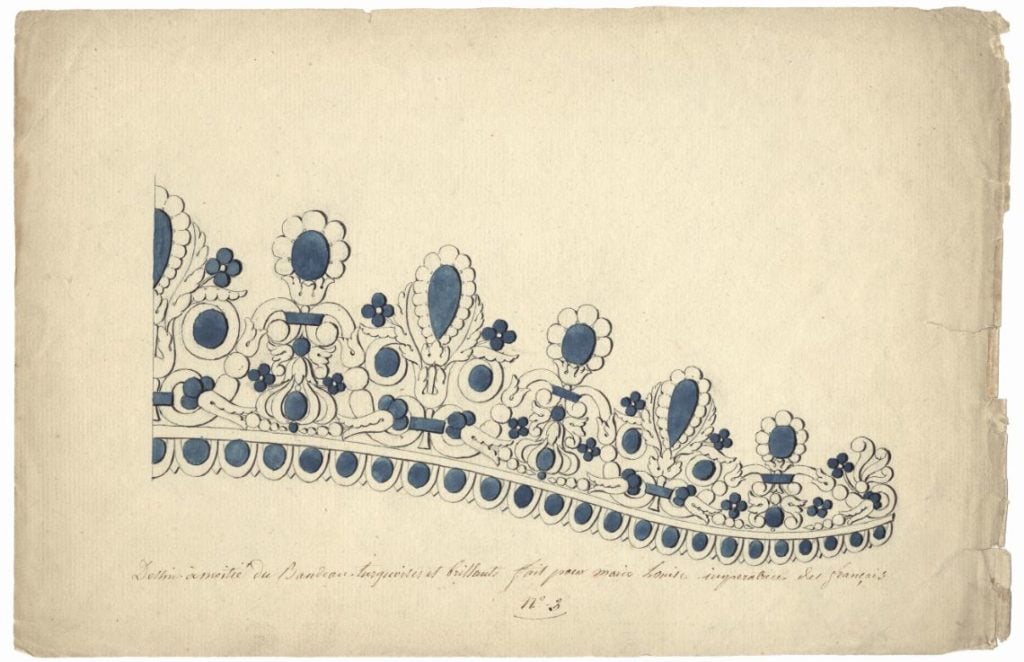
A preparatory sketch for the turquoise headband for Mairie Louise Empress of France (1811). Courtesy of Collection Chaumet, Paris.
The palpable collector enthusiasm for works on paper in Paris is reflected in part in the number of shows this week that shine a spotlight on drawings, including a sister fair called Drawing Now that is dedicated exclusively to contemporary drawings, held at the Carreau du Temple in the Marais district of Paris. Another show at the Musée Condé in Chantilly, some 35 miles north of Paris, presents a selection of 21 original etchings by Rembrandt and his entourage from the collections of the Duc d’Aumale, all pieces that are being publicly exhibited for the first time ever.
For those interested in further immersion in the world of jewelry drawings, an exhibition titled “The Gouachés: A Unique and Little Known Art” runs through April 1 at the Piscine de Roubaix, an art center in Northern France, which features jewelry drawings from the archives of the 19th-century jeweler Dael & Grau.

Sketch from Chaumet.
Finally, after the Salon du Dessin closes on Monday, Chaumet will continue to show a different set of drawings in a second show (March 22–March 30) called “The Art of the Stroke“—a title meant to evoke the elegance of a graphite pencil mark—that explores the theme of architecture in jewelry design. The show will be held in the reception rooms of Chaumet’s own historic home on the Place Vendôme and will feature both drawings from its own collections and works by students of Paris’s École des Beaux-Arts, the prestigious art school. Over the years, the maison has recruited draughtsmen from that school, and also plans to sponsor the construction of a new venue within its confines dedicated to showing and promoting works on paper.
For historic jewelry houses like Chaumet, a drawing is more than just a step in the preparation of a piece of jewelry—it is a work of art that is essential to the house’s creativity and identity. The drawings on display at the fair make that case convincingly, creating a thread that forms an inextricable link between the maison’s storied heritage and its contemporary collections today.
